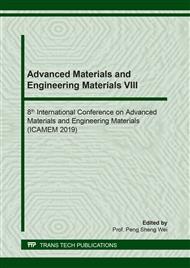[1]
L. N. Zhang, P. Wang, J. X. Dong and M. C. Zhang, Microstructures' Effects on High Temperature Fatigue Failure Behavior of Typical Superalloys, Materials Science and Engineering A. 587 (2013) 168-178.
DOI: 10.1016/j.msea.2013.08.065
Google Scholar
[2]
H. Yang. R. Bao, J. Zhang, L. Peng and B. Fei, Crack Growth Behaviour of a Nickel-Based Powder Metallurgy Superalloy under Elevated Temperature, International Journal of Fatigue. 33 (2011) 632-641.
DOI: 10.1016/j.ijfatigue.2010.11.003
Google Scholar
[3]
R. Konečná, L. Kunz, G. Nicoletto and A. Bača, Long Fatigue Crack Growth in Inconel 718 Produced by Selective Laser Melting, International Journal of Fatigue. 92 (2016) 499-506.
DOI: 10.1016/j.ijfatigue.2016.03.012
Google Scholar
[4]
P. Paris and F. Erdogan, A Critical Analysis of Crack Propagation Laws, Journal of Basic Engineering. 85 (1963) 528-533.
DOI: 10.1115/1.3656900
Google Scholar
[5]
K. Tanaka, Fatigue Crack Propagation from A Crack Inclined to the Cyclic Tensile Axis, Engineering Fracture Mechanics. 6 (1974) 493-507.
DOI: 10.1016/0013-7944(74)90007-1
Google Scholar
[6]
B. A. Bilby, A. H. Cottrell, F. R. S. and K. H. Swinden, The Spread of Plastic Yield from A Notch, Proceedings of the Royal Society A. 272 (1963) 304-314.
Google Scholar
[7]
X. Yan, S. Du, and Z. Zhang, Mixed-mode Fatigue Crack Growth Prediction in Biaxially Stretched Sheets, Engineering Fracture Mechanics. 43 (1992) 471-475.
DOI: 10.1016/0013-7944(92)90115-u
Google Scholar
[8]
F. Erdogan and G. C. Sih, On the Crack Extension in Plates under Plane Loading and Transverse Shear, Journal of Basic Engineering. 85 (1963) 519-525.
DOI: 10.1115/1.3656897
Google Scholar
[9]
L. P. Borrego, F. V. Antunes, J. M. Costa and J. M. Ferreira, Mixed-Mode Fatigue Crack Growth Behaviour in Aluminium Alloy, International Journal of Fatigue. 28 (2006) 618-626.
DOI: 10.1016/j.ijfatigue.2005.07.047
Google Scholar
[10]
H. A. Richard, Some Theoretical and Experimental Aspects of Mixed Mode Fractures, In: Fracture 84. (1984) 3337-3344.
DOI: 10.1016/b978-1-4832-8440-8.50358-6
Google Scholar
[11]
ASTM Standard E647, Standard Test Method for Measurement of Fatigue Crack Growth Rates, ASTM international. (2016).
DOI: 10.1520/stp33449s
Google Scholar
[12]
T. Y. Kim and H. K. Kim, Mixed-Mode Fatigue Crack Growth Behavior of Fully Lower Bainite Steel, Material Science & Engineering A. 580 (2013) 322-329.
DOI: 10.1016/j.msea.2013.05.065
Google Scholar
[13]
R. S. Barsoum, On the Use of Isoparametric Finite Elements in Linear Fracture Mechanics, International Journal for Numerical Methods in Engineering. 10 (1976) 25-37.
DOI: 10.1002/nme.1620100103
Google Scholar
[14]
T. L. Anderson, Fracture Mechanics, third ed., Taylor & Francis, (2005).
Google Scholar


